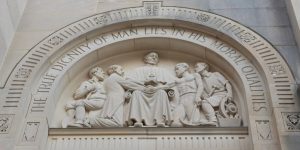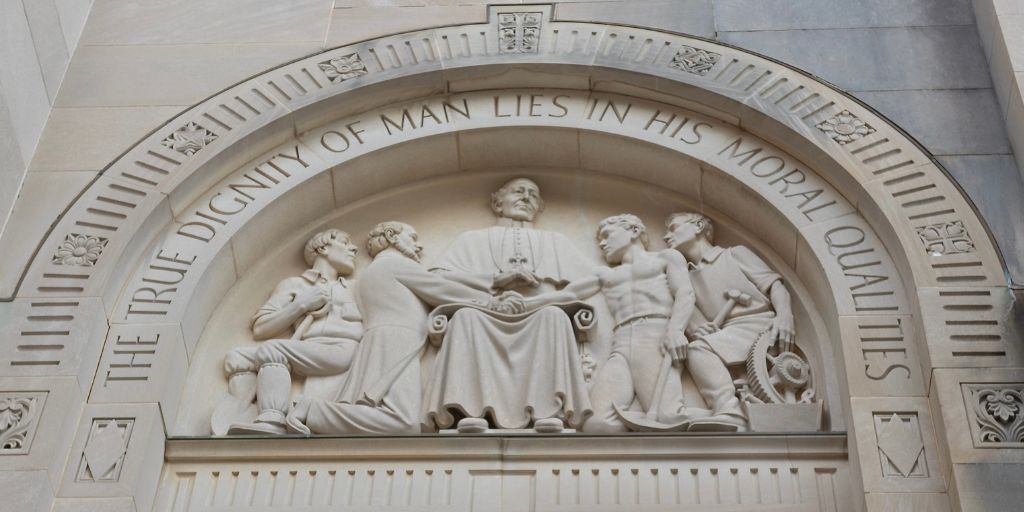
From the Desk of Dr. Geraldine M. Rohling, MAEd, DSG, Archivist-Curator Emerita
With the election of a new pope, the name that is chosen is often reflective of the philosophy or theology – or both – that will guide the new pope. For this reason, it is worth pausing and thinking of the encyclical Rerum Novarum of Pope Leo XIII, which is honored and remembered on the west side of the National Shrine.
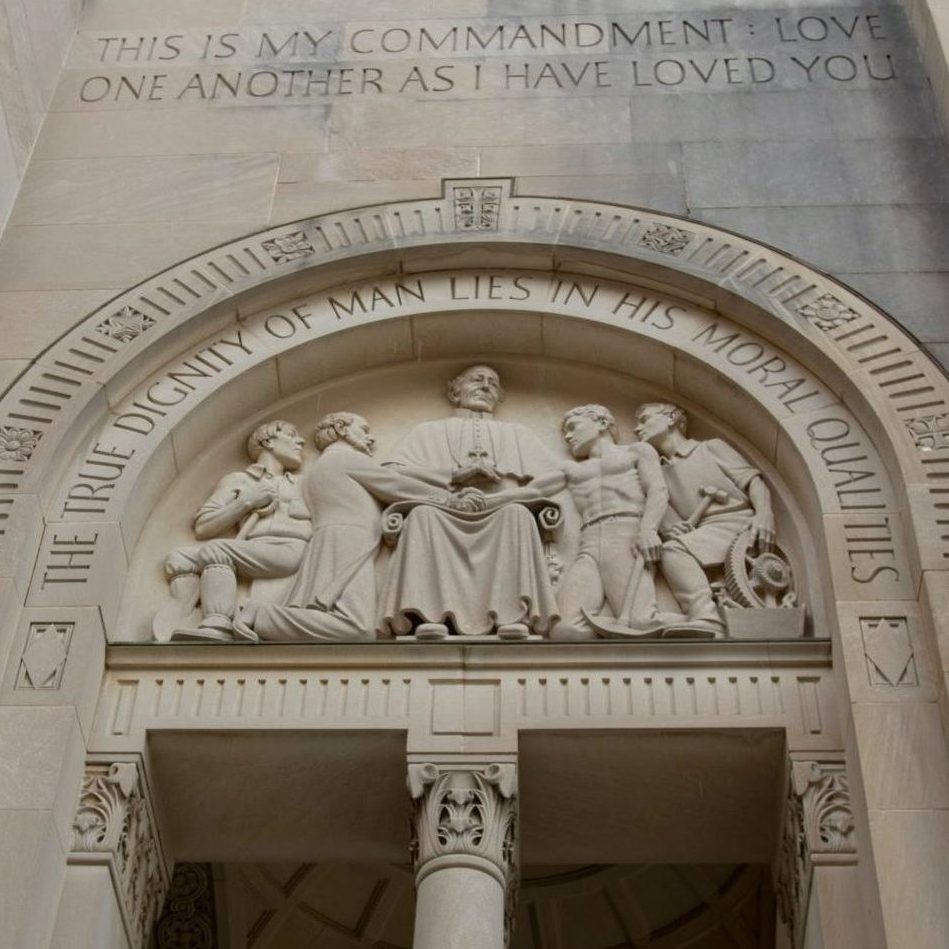
Rerum Novarum at the National Shrine
Nestled in an obscure corner on the north exterior wall of the west porch of the National Shrine, there is a tympanum sculpted in relief, Rerum Novarum, by Adolph Block. The sculpture is an homage to the encyclical of the same name by Pope Leo XIII (1878-1903), which was promulgated on May 15, 1891, “the fourteenth year of Our pontificate.”
The west façade of the National Shrine is devoted to themes and symbols of Christian charity. The numerous saints, symbols, and texts utilized on this side of the Shrine are those which are exemplary of this virtue. Above the center door is the mosaic tympanum of Jesus as The Good Samaritan, by Francis Scott Bradford.
This seems to raise the question of why, amid sculptures and mosaics devoted to acts of Christian charity, this papal encyclical is so special as to be ‘written’ in stone.
The Significance of Rerum Novarum
Rerum Novarum – literally translated: “new things” – often subtitled: “On the Condition of the Working Classes,” earned Leo XIII the names the “Social Pope” and the “Pope of the Workers.” This encyclical was the foundation for modern thinking on the social doctrines of the Catholic Church, which would influence the thought and practices of future popes.
The encyclical outlined the rights of workers – a fair wage, safe working conditions, the formation of trade unions – while affirming the rights to property and free enterprise, opposing both socialism and laissez-faire capitalism, literally translated as “leave it alone,” a capitalism which opposes government involvement in business affairs.
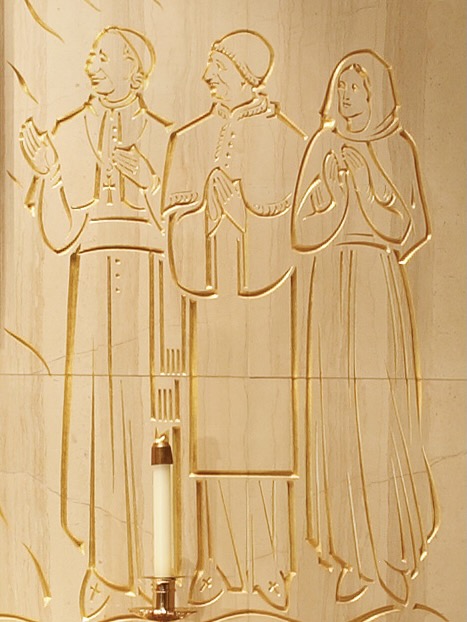
Rerum Novarum introduced the idea of subsidiarity, which contends that issues should be handled at multiple levels of organization and not just by a centralized authority. The development of this concept in Catholic social teaching is rooted in the natural law philosophy of Thomas Aquinas. Ideas, positions, and thoughts, presented in Rerum Novarum were supplemented in later papal encyclicals, e.g., Quadragesimo Anno (Pius XI, 1931), Mater et Magistra (John XXIII, 1961), and Centesimus Annus (John Paul II, 1991).
The encyclical was not a “one-off” or a “shot in the dark” – it was the evolution of thought and experience of a life spent in pursuit of Christian charity, equality, and love of the poor, the working class, and the people entrusted to his care as pope and to the Church. This encyclical is considered a “foundational text of modern Catholic social teaching.”
The placement of Rerum Novarum at the National Shrine was also well thought-out. The persons, symbols, texts, and moments of Church history that were critiqued for their impact and influence on Church teaching and thought as it related to charity were many. The scholars and artists comprising the iconography committee of that period chose methodically, thoughtfully, and democratically as to what they wished to place in stone to define the teachings of the Church.
Pope Leo XIII’s Early Life and Career
At age 67, Gioacchino “Vincenzo” Raffaele Luigi Pecci (1810-1903) was elected pope on February 20, 1878, and took the name Leo XIII. At the time of his death on July 20, 1903, he was 93 years of age, making his reign (25 years) the fourth-longest, following that of John Paul II (26 years), Pius IX (31 years, his immediate predecessor), and Peter the Apostle (34-38 years).
Pecci was of noble or “patrician” birth. He and his older brother Giuseppe decided early in life that theirs would be a priestly vocation. Vincenzo became a secular priest, while his brother became a Jesuit. Vincenzo studied at the Pontifical Ecclesiastical Academy, where priests were trained for the diplomatic corps and service in the Vatican secretariat of state. During this time, he came quickly to the attention of Vatican officials. At age 27, eleven months before being ordained a priest on December 31, 1837, Vincenzo was appointed a “personal prelate” or a prelate of honor, known as a “domestic prelate,” in 1968, to Pope Gregory XVI, with the title of Monsignor. Shortly after his ordination, he was appointed a provincial administrator to the smallest papal province, Benevento. This was the start of his diplomatic and episcopal career.
Pecci moved rapidly in the ecclesiastical ranks and enjoyed popularity among his people. While Archbishop of Perugia (1846-78), Pecci took personal interest in founding Catholic charities, including homeless shelters, soup kitchens, and most notably the creation of branches of “Bank, Monte di Pietà,” which provided low-interest loans for low-income people.
When elevated to the College of Cardinals, the funds and resources that would have gone to the festivities were donated to the victims of the earthquakes and floods that were plaguing his people. During his last years in Perugia, Pecci addressed the role of the Church in modern society. He defined the Church as “the mother of material civilization” because it upheld the human dignity of working people, opposed the excesses of industrialization, and developed large-scale charities for the needy. This concern would be a significant part of his papacy.
In August of 1877, Pope Pius IX appointed Pecci camerlengo, which meant he had to leave Perugia for Rome. Six months later, Pope Pius IX died on February 7, 1878.
The Papal Conclave of 1878
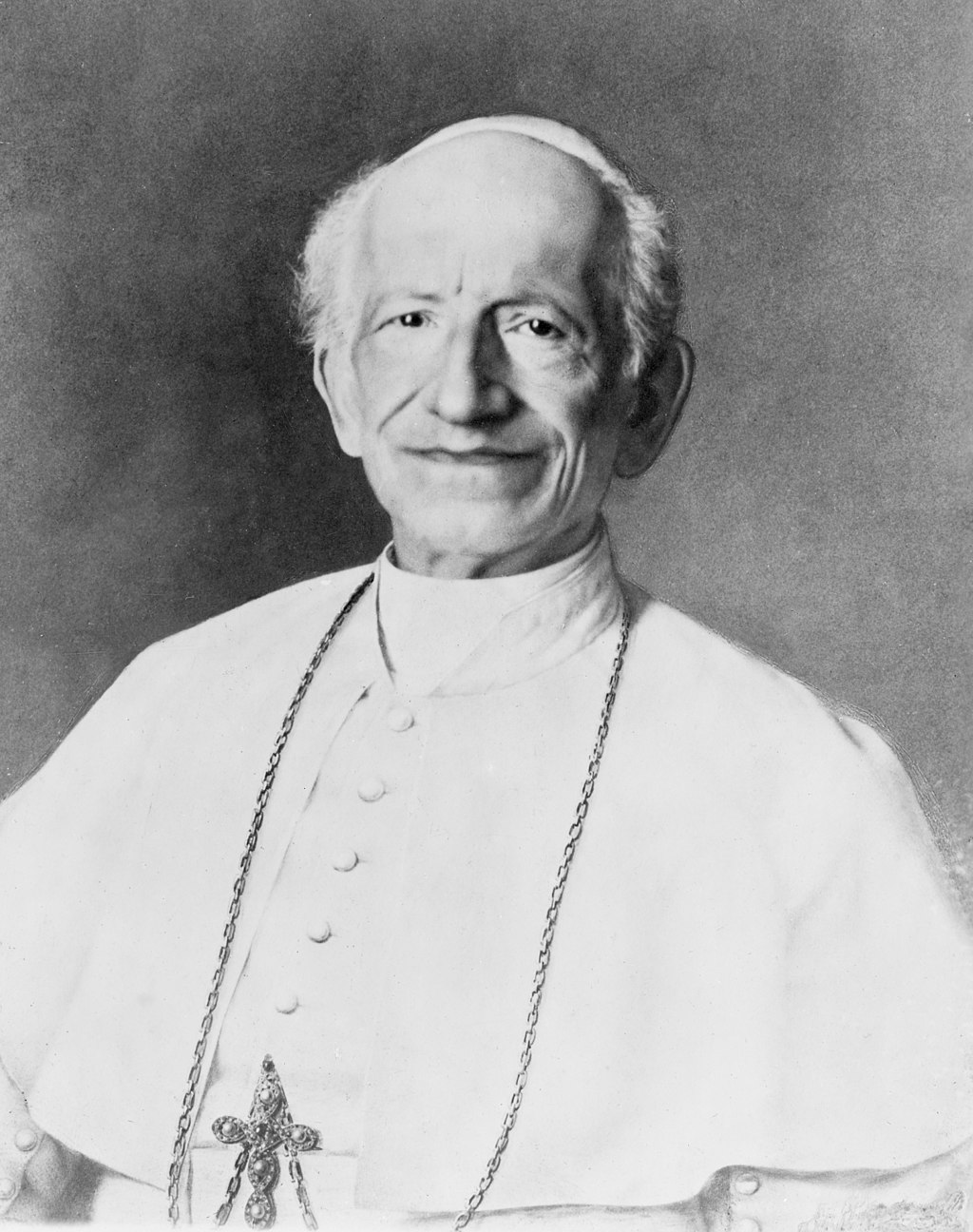
The conclave assembled in Rome on February 18, 1878; there were 61 voting cardinals. They discussed the relations of church and state in Europe, specifically Italy; the divisions occurring in the Church; and the status of the First Vatican Council, which began in December 1869. These topics remain relevant in 2025.
Camerlengo Pecci took new, innovative measures for the conclave: he had a kitchen installed within the enclosure and a sufficient staff of cooks and other servants. Thus, all food was prepared “within the conclave.” This was to prevent “any occasion or pretext” for transgressing the sacred rules of enclosure and secrecy. Curiously, years later, Cardinal Donnet, Archbishop of Bordeaux, who was seated next to Cardinal Pecci, would break this “secrecy” when telling of a moment during the conclave when Pecci’s election was becoming clear. He noted that “the trouble, the emotion, the terror of the humble-minded Camerlengo became uncontrollable.” Donnet described his conversation with Pecci, “I remarked that, Cardinal Pecci, upon hearing his own name mentioned so often, and that everything pointed to him as the successor of Pius IX, great tears rolled down his cheeks, and his hand shook so violently that the pen it held fell to the ground. I picked it up and gave it to him, saying, ‘Courage.’”
When asked what name he would take, Cardinal Pecci answered: “Leo XIII, in remembrance of Leo XII, whom I have always venerated.”
The Papacy of Pope Leo XIII
Pope Leo XIII began his papacy by encouraging understanding between the Church and the modern world. He re-founded the Vatican Observatory and re-asserted the doctrine of the co-existence of science and religion. He influenced the Mariology of the Catholic Church by promoting the rosary, which he mentioned in 11 encyclicals, thus earning him the title “the Rosary Pope.”
Leo XIII maintained a healthy interest in international politics and friendly foreign relations. The United States attracted his attention and his admiration. It was Leo XIII who gave the American Catholic Church its second cardinal: James Cardinal Gibbons, Archbishop of Baltimore.
The accomplishments of the papacy of Leo XIII are many and best understood by reading one of his many biographies.

